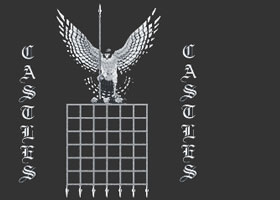The first Roman Fort at Londinium falls to Boudicca
The original Roman fort at Londinium was destroyed by the Iceni tribe in their rebellion against the Romans, led by Boudicca, Queen of the Iceni in 60AD. Caius Suetonius Paullinus was the Roman governor of Britain at this time. Boudicca first attacked the capital of Roman England Camulodunum (now Colchester). It was not well-defended and the Romans were easily defeated against the Iceni force of over 100,000. Queen Boudicca's army then marched on Londinium (London). Suetonius strategically abandoned Londinium. The army of Queen Boudicca army burned Londinium to the ground and massacred the 25,000 inhabitants who had not fled. The Romans gained controlled of the Iceni rebels and a new Roman fort at Londinium was quickly erected following the defeat of Boudicca. The London Wall - built by the Romans
The Romans had learnt the lesson taught to them by the terrible Queen Boudiccea of the Iceni and looked to defending the town of Londinium. By the 200BC all except the river side of Londinium was totally enclosed by a massive defensive wall. Remains of the Roman wall can be seen from Noble Street and St Alphage's churchyard but the most famous Roman remains are at Tower Hill and a section of the Roman Wall has been preserved in the Tower of London. The town of Londinium had several exits from the enclosure wall. A Western exit was situated on the site of Newgate. Roman Roads led to the Londinium gates. The 'Newgate' had a gate house and was flanked by square towers - the 'Newgate' gatehouse was about 100 feet wide. Londinium boasted a large courthouse (basilica) and market place (forum) which was located on the site of present day Cornhill. Roman Temples at Londinium
Londinium housed many Roman Temples. Londinium was not the capital - this was Colchester or, given its Roman name, Camulodunium. St Pauls Cathedral was built on the site which once housed a Roman Temple dedicated to the goddess Diana. Another Roman Temple dedicated to the God Appollo once stood at Westminster. Roman Temple of Mithras discovered in London (Londinium)
Traces of our Roman ancestors are still being discovered. In 1954 excavations North of Cannon Street led to the discovery of the Roman Temple of Mithras. This Roman Temple was built on the East bank of the Wallbrook stream which is an estuary of the River Thames - the remains can be viewed at Bucklesbury House in Victoria Street. The re-constructed temple is now on an elevated platform some six feet above street level. The remains of two square Romano-Celtic temples have also been found at a Roman temple complex in Southwark in South London. Londinium
The Romans built the large city of Londinium. In 410AD the Roman homeland were attacked by barbarian tribes and the Romans left Britain in an attempt to halt the Decline of the Roman Empire. No new innovations were made to British architecture until the advent of the Romanesque Architecture style of the Normans and their massive stone castles. Londinium was re-named London and the famous Tower of London was built by William the Conqueror. | 
